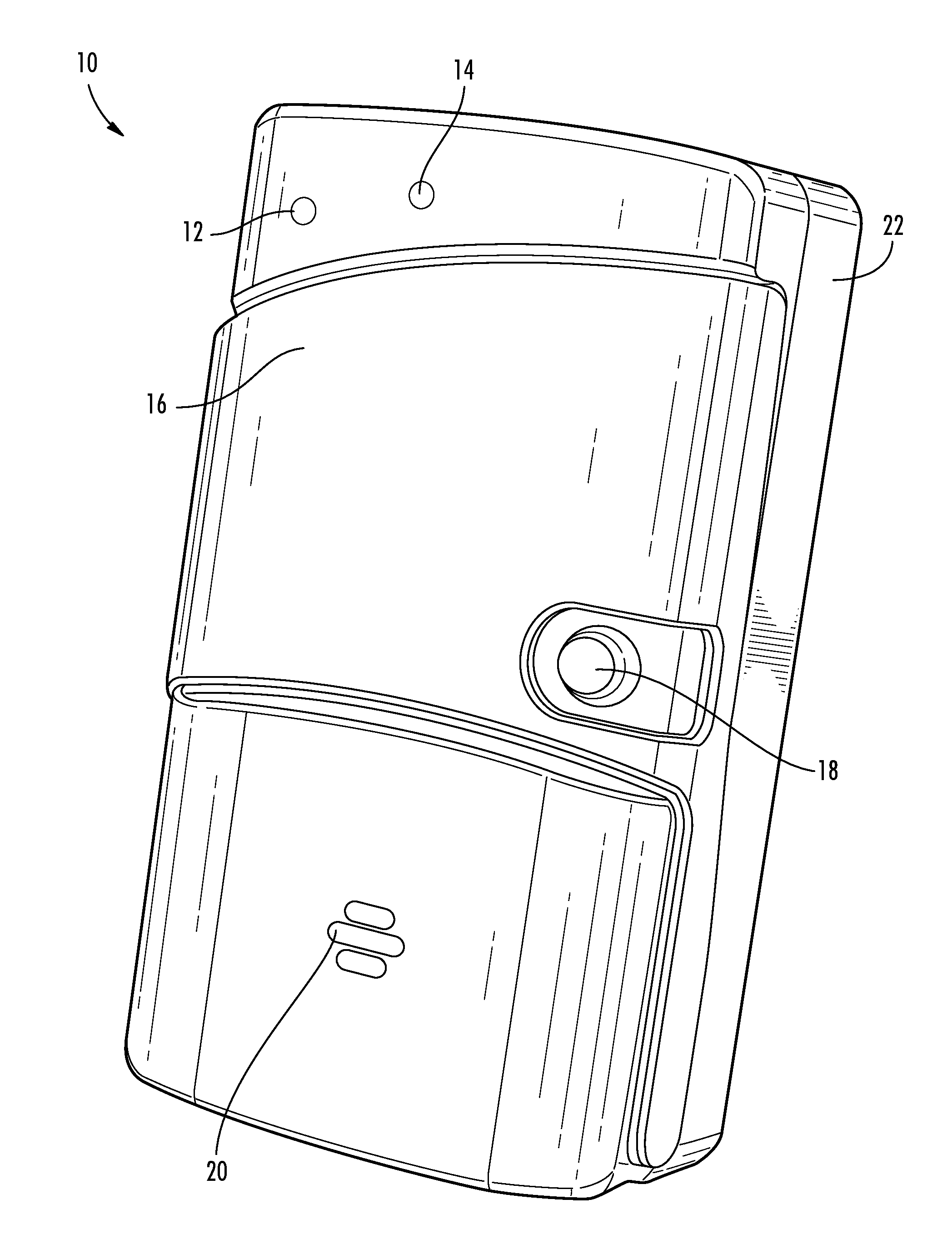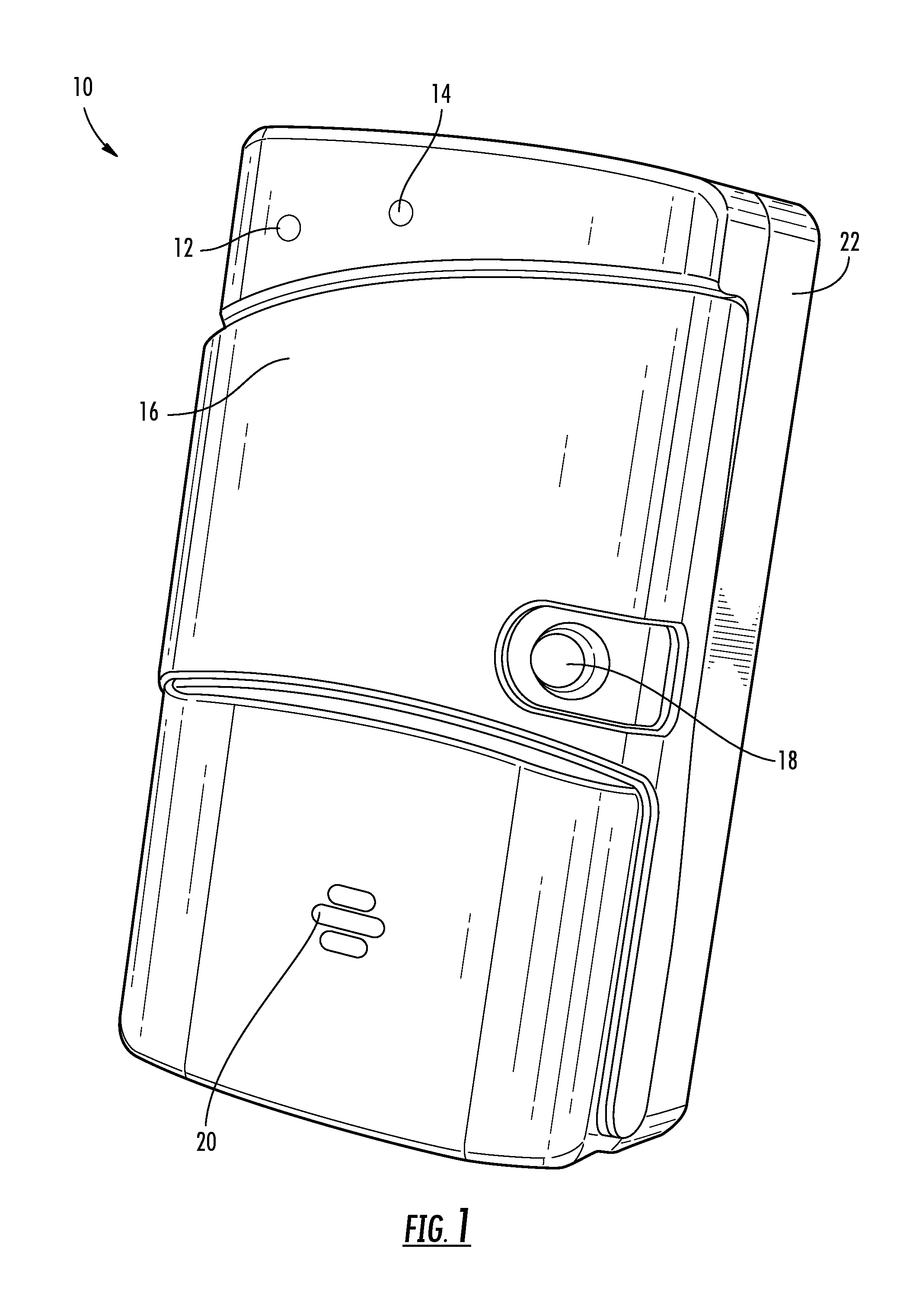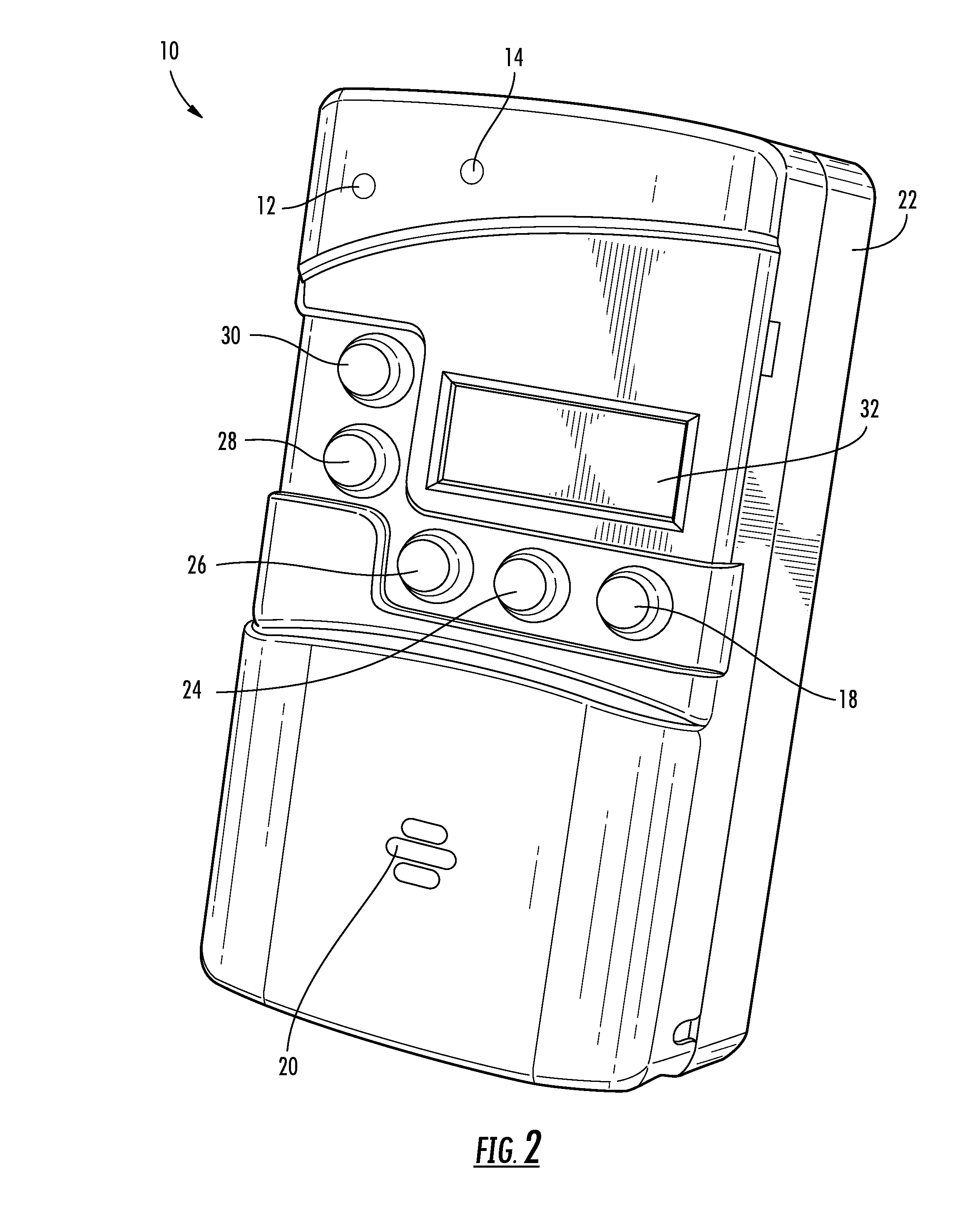[0020]In another exemplary embodiment, the technology described herein provides a tornado warning device. The tornado warning device includes: a portable electronic device housing; an audio siren, having a volume, disposed within the housing and configured to actuate upon an occurrence of a predetermined event; a receiver disposed within the housing to receive signals and Specific Area Message Encoding (SAME) messages at one or more National Weather Service (NWS) weather radio frequencies; a digital decoder disposed within the housing coupled to the receiver and configured to filter out all SAME messages except for a single weather warning message type of Tornado Warning code (TOR) and a Required Weekly Test (RWT) code; a processor coupled to the receiver and the digital decoder to control the receiver and decoder and to actuate the audio siren upon the occurrence of the predetermined event; a power source; a memory for storing a plurality of signal values and frequencies, a plurality of message values, and a plurality of geographical codes, even after an interruption in the power source; and a test indicator light, controlled by the processor, to indicate a current state of the single event severe weather alarm and to indicate whether the Required Weekly Test (RWT) code was processed properly, wherein the test indicator is configured to illuminate in a first color and to change illumination to a second color upon receipt and process of the Required Weekly Test (RWT) code.
[0021]The tornado warning device also can include: a user interface coupled to the processor, the user interface having at least a “mute” selection, a “back” selection, an “enter” selection, a “frequency” selection, and a “county” selection; a visual display coupled to the user interface; a signal strength indicator visible on the visual display, wherein the processor is configured to allow an operator, through the user interface, to select the frequency of reception of the receiver based on a frequency determination from review of the signal strength indicator; a county code indicator visible on the visual display, wherein the processor is configured to allow the operator, through the user interface, to select an applicable county code based on a geographic location or to leave the county code field without a data input in order to default to all counties with a local range of the weather alarm; and a sub-county code indicator visible on the visual display, indicative of a region within a county, wherein the processor is configured to allow the operator, through the user interface, to select an applicable sub-county code based on geography or to leave the sub-county code field without a data input in order to default to all regions within a county.
[0022]The tornado warning device further can include: a retractable electrical prong assembly to plug the single event severe weather alarm into a traditional power source outlet and with which to mount the alarm to a wall surface; a strobe light to indicate to those who cannot hear that the siren has been activated; a software implemented logic circuit coupled to the digital decoder and configured to filter out all SAME messages except for single the warning message event code and the Required Weekly Test (RWT) codes, wherein the processor is configured to deny access by an operator of the single event severe weather alarm to the digital decoder; and a battery backup system disposed within the housing to provide power to the single event severe weather alarm and to provide portability of the single event severe weather alarm. In this embodiment, the volume of the audio siren is preset to remain unmanipulated by an operator, and thus not raised, lowered, or turned off. In this embodiment, the processor is configured to automatically select the frequency of reception of the receiver based on geography and signal strength.
[0023]In another exemplary embodiment, the technology described herein provides a method to indicate the occurrence of a severe weather alert. The method includes: providing a single event severe weather alarm having: a portable electronic device housing; an audio siren, having a volume, disposed within the housing and configured to actuate upon an occurrence of a predetermined event; a receiver disposed within the housing to receive signals and Specific Area Message Encoding (SAME) messages at one or more National Weather Service (NWS) weather radio frequencies; a digital decoder disposed within the housing coupled to the receiver and configured to filter out all SAME messages except for a single weather warning message event code and a Required Weekly Test (RWT) code; a processor coupled to the receiver and the digital decoder to control the receiver and decoder and to actuate the audio siren upon the occurrence of the predetermined event; a power source; a memory for storing a plurality of signal values and frequencies, a plurality of message values, and a plurality of geographical codes, even after an interruption in the power source; and a test indicator light, controlled by the processor, to indicate a current state of the single event severe weather alarm and to indicate whether the Required Weekly Test (RWT) code was processed properly, wherein the test indicator is configured to illuminate in a first color and to change illumination to a second color upon receipt and process of the Required Weekly Test (RWT) code; determining whether a county code has been selected for the alarm; selecting, if not previously selected or if reselecting, a county code; filtering the receiver for the county code selected; receiving SAME messages; processing the received SAME messages to identify whether a single weather warning message event code has been received, and upon receipt of a single weather warning message event code to actuate the audio siren; and processing received SAME messages to identify whether a Required Weekly Test (RWT) code has been received, and upon receipt of the RWT code to actuate the test indicator light to indicate the state of the alarm and the last weekly test. In at least one embodiment of the method, the single warning message event code is the Tornado Warning code (TOR).
[0024]There has thus been outlined, rather broadly, the more important features of the technology in order that the detailed description thereof that follows may be better understood, and in order that the present contribution to the art may be better appreciated. There are additional features of the technology that will be described hereinafter and which will form the subject matter of the claims appended hereto. In this respect, before explaining at least one embodiment of the technology in detail, it is to be understood that the invention is not limited in its application to the details of construction and to the arrangements of the components set forth in the following description or illustrated in the drawings. The technology described herein is capable of other embodiments and of being practiced and carried out in various ways. Also, it is to be understood that the phraseology and terminology employed herein are for the purpose of description and should not be regarded as limiting.
 Login to View More
Login to View More  Login to View More
Login to View More 


